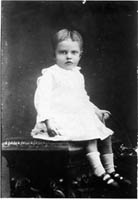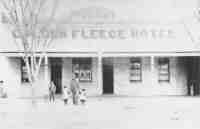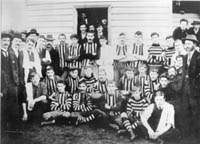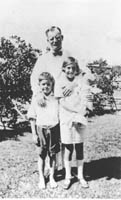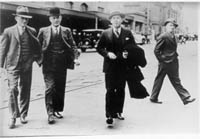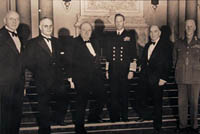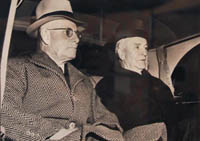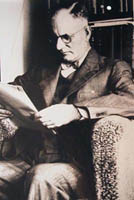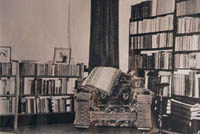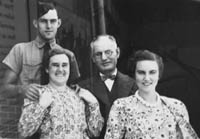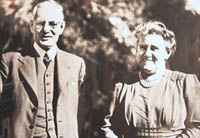
Who was John Curtin and how did he come to lead Australia during World War II?
Follow his path from working class childhood in country Victoria to wartime leadership in Canberra.
Jan 8 1885 John Curtin born at Creswick in Victoria to Irish - born John Curtin and Kate Bourke
c. 1890 Curtin family leaves Creswick, moves from hotel to hotel
with John Sr working as hotel manager
YARRA BANK YOUTH
c.1899 Curtin family settles in Melbourne suburb of Brunswick. Curtin leaves school aged about 14.
1902 Meets his mentor Frank Anstey (Victorian labour politician) and Tom Mann (famous British socialist and union leader).
1903-1911 Works as an estimates clerk at the Titan Manufacturing Company in South Melbourne.
1906 Joins the Victorian Socialist Party (VSP). First article published in VSP journal the Socialist.
1907-1908 President then Secretary of the Brunswick branch of the Political Labor Council (later to become the Australian Labor Party).
1911-1915 Appointed secretary then first Federal President of the Timber Workers' Union.
1916
Appointed secretary of the Trades Hall Council anti-conscription
campaign
Spends time in Lara Hospital being treated for drinking
problem
The Westralian Worker Office
in Perth, c 1920. Records of the Australian Labour Party WA Branch. JCPML00379/1.
HEADING WEST
Feb 1917 Moves to Perth as Editor of the Westralian Worker
April 21 1917 Marries Elsie Needham at Registrars Office in Perth
Dec 1917 Daughter Elsie born
Jan 1921 Son John born
1924 Represents Australia at annual conference of International Labour Organisation in Geneva
1927-1928 Member of Commonwealth Royal Commission into Child Endowment
Records of the Curtin family. John Curtin with his children, 1930. JCPML00004/16.
Nov 1928 Wins federal seat of Fremantle, serves in Labor Opposition.
Feb 1929 Elected to Labor caucus executive.
Oct 1929 Labor wins government. Curtin retains seat of Fremantle, but is not elected to Scullin's ministry.
Dec 1931 Labor is defeated. Curtin loses his seat and returns to Perth. Permanently gives up alcohol, works as a journalist.
Sept 1934 Curtin wins seat of Fremantle again, returns to Canberra to serve in Labor Opposition.
Oct 1935 Curtin elected by one vote to replace retiring Scullin as leader of the ALP.
Oct 1937 Retains seat of Fremantle in federal election.
Sept 1940 Retains seat of Fremantle again, but by narrow margin.
Oct 28 1940 Curtin appointed to newly established Advisory War Council.
Xmas greetings from 3 Squadron
RAAF
to the prime minister. National Archives of Australia. M1416/1, 76.
Oct 3 1941 Fadden government is defeated in Parliament. Curtin is invited to form a ministry.
Oct 7 1941 Curtin is sworn in as Prime Minister.
Dec 26 1941 Curtin states 'Australia looks to America`.
Feb 1942 Curtin clashes with Churchill over the return of the 6th & 7th Divisions of the AIF.
Feb 1943 9th Division of the AIF returns to Australia from the Middle East on Curtin's insistence.
Feb 1943 Curtin convinces ALP to accept a measure of conscription for overseas service; Militia Bill passed by Parliament.
Aug 21 1943 Landslide victory for ALP in federal election.
Curtin with US Secretary of State Cordell Hull, Washington DC, 1944. Records of the Curtin family. JCPML00376/106.
April-June 1944 John and Elsie Curtin travel to USA, Britain and Canada.
Nov 1944 Curtin suffers a heart attack and spends two months in a Melbourne hospital.
July 5 1945 Curtin dies at the Lodge.
- 1890s
Depression in Australia
- 1901
Federation of colonies to form the Commonwealth of
Australia
- July 1908
'Australian Labor Party' becomes official name of the parliamentary
wing of the labour movement
- Aug 4 1914
World War I begins
- Oct 1916
& Dec 1917 Conscription referenda in Australia
defeated
- 1917
Russian Revolution
- Nov 11 1918
World War I ends
- Jan 1920
Australian Country Party formed
- Nov 1920
Communist Party of Australia formed
- May 9 1927
Federal Parliament sits for first time in the new Australian
capital of Canberra
- Nov 1928
National-Country Party coalition victory at federal
election
- Oct 1929
Victory for Scullin's ALP at federal election
- Wall Street
crashes and the Great Depression begins
- Jan 1930
Don Bradman scores a record 452 not out for NSW against
QLD
- Nov 1930
Phar Lap wins Melbourne Cup
- Dec 1931
Scullin's Labor Government falls, victory for Lyons' United
Australia Party
- Sept 1934
Another United Australia Party victory in federal
election
- 1934
Australia starts to recover from Great Depression
- 1936 King
Edward VIII abdicates
- Oct 1937
Another United Australia Party victory in federal
election
- April 1939
Menzies takes over as Prime Minister after the death of
Lyons
- Sept 3 1939
Australia declares war on Germany
- June 1940
Australia declares war on Italy when Italy allies with
Germany
- Sept1940
Marginal victory for United Australia Party in federal election.
Curtin rejects Menzies' offer to form an all-party
government
- Aug 1941
Menzies is replaced as Prime Minister by Country Party leader
Arthur Fadden
- Oct 3 1941
Fadden Government is defeated, ALP is invited to form
government
- Nov 19 1941
German raider sinks HMAS 'Sydney' off WA coast with loss of 645
lives
- Dec 7 1941
Japanese attack Pearl Harbor
- Dec 8 1941
Australia declares war on Japan
- Feb 15 1942
Singapore falls to the Japanese
- Feb 19 1942
Japanese bomb Darwin for the first time
- March 17
1942 US General Douglas MacArthur arrives in
Australia
- May 31-June
1942 Japanese midget submarines raid Sydney Harbour
- May 1942
Battle of the Coral Sea thwarts Japanese plans to isolate
Australia
- Nov 1942
Australian troops recapture Kokoda in Papua
- Sept-Dec
1943 Allied victories lead to Japanese retreat in New
Guinea
- April 12
1945 US President FD Roosevelt dies
- May 7 1945
War against Germany ends
- July 5 1945
Deputy Prime Minister Frank Forde becomes Prime Minister after
Curtin's death
- July 13
1945 Ben Chifley becomes Prime Minister
- Aug 1945
Allies drop atomic bombs- on Hiroshima and Nagasaki
- Aug 15 1945Pacific War ends
John Curtin was a modest and reserved man - perhaps an unlikely prime minister. Yet few politicians before or since have enjoyed such universal respect and affection from those on both sides of politics.
He led an austere and simple life, and seemed to remain unaffected by the power of high office.
The front room of the Curtin's
Cottesloe home, 1943. Records of the Curtin family. JCPML00376/35.
Despite his choice of career, Curtin was extremely sensitive to criticism, and prone to bouts of dark depression. Loneliness plagued him during the years he spent in Canberra, separated from his family who still lived in Perth.
He was seen by many as a man of principle, devoted to the cause of the worker, and loyal to the Labor Party to the end.
THE CURTIN FAMILY
Despite his long absences from home, Curtin had a close relationship with his family. During most of his time as Prime Minister, his wife Elsie lived in Perth, where their daughter Elsie and son John also lived.
There she maintained their Cottesloe home, attended to Curtin's electorate correspondence, and became involved in community activities, including the Labor Women's Organisation.
The last photo of John and Elsie
together at the Lodge, Canberra, 1945. Records of the Curtin family. JCPML00376/29.
She usually made two trips to Canberra each year, staying for a few months at a time.
During Curtin's final illness, Elsie lived at the Lodge continuously for six months. She was with her husband when he died. Elsie Curtin was appointed CBE (Commander of the Order of the British Empire) in 1970 for her services to the community. She died in 1975 at the age of eighty-four.
